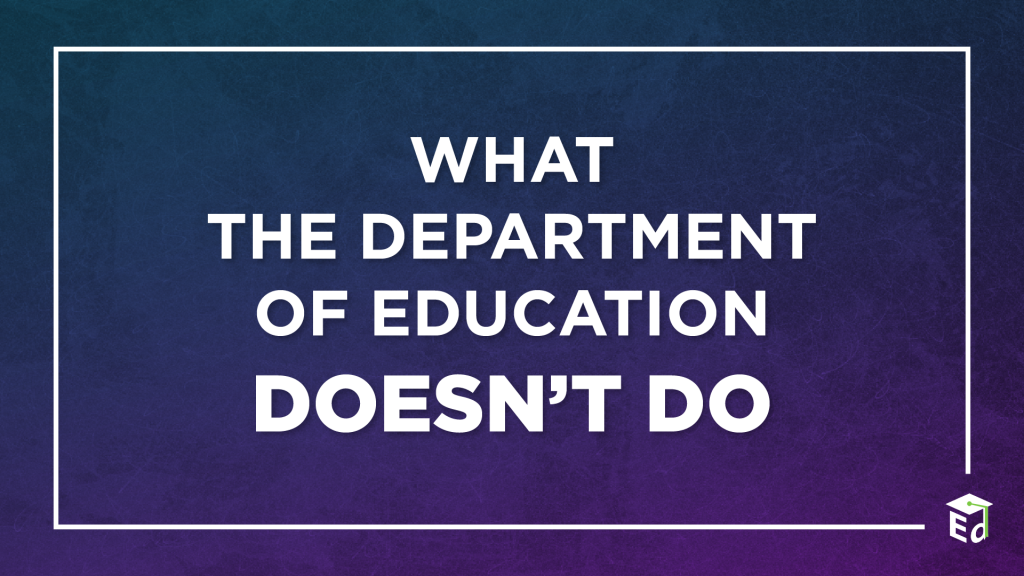
By: Jim Blew, Co-founder of the Defense of Freedom Institute
Over its 45-year history, the U.S. Department of Education has persistently increased its power over American K-12 education. Then, on March 20, 2025, President Trump ordered the end of Education Department dominance, issuing an executive order entitled “Improving Education Outcomes by Empowering Parents, States, and Communities.” As Secretary McMahon has said, it is time for the Department to begin its final mission and shift power back to states, local communities, and families.
Many Americans have expressed concern that eliminating the cabinet-level bureaucracy will strand K-12 teachers and students without resources or support. But these worries are based on misunderstandings about what the Department actually does for K-12 education, and what it doesn’t do. As the bureaucracy gets dismantled, it’s worth unpacking the Department’s role—and why American education will be better off when it’s gone.
The Department Doesn’t Control School Curriculum
One common misunderstanding is that the federal Department determines academic standards, curriculum, and instruction in public schools. That is not the case. Those are state and local responsibilities. In fact, federal law explicitly prohibits the Department from any “direction, supervision, or control” of curriculum or instruction.
Americans might understandably think the Department does set curriculum, because they remember how the Obama Administration nudged states to adopt the Common Core State Standards using financial and regulatory incentives. Those standards regrettably led many districts to adopt unpopular curriculum and instructional methods. The resulting outcry led Congress to reinforce its prohibitions against the Department influencing curriculum.
While the Department does not influence curriculum and instruction, it does supplement the money spent on local schools, targeting economically disadvantaged students and students with disabilities. Even after Congress eliminates the Department, it will certainly continue to appropriate funds for those students.
The Department Doesn’t Recruit or Pay Teachers
Another misconception: teacher shortages are the federal government’s fault. But the federal Department plays no role in certifying teachers, hiring them, or setting their salaries and benefits. All of that is done by states and local districts; they make the everyday rules for K-12 educators and staff.
Congress has asked the Department to manage one program aimed at raising teacher quality and effectiveness, costing about $2 billion annually. Most of this ESEA Title II-A money has gone toward typical professional development programs, even though Congress does allow districts to use the funds in other ways. Sadly, Title II-A programs have not improved teacher effectiveness much, if at all.
If Congress wants to get better results for its Title II appropriation, they could roll it into a block grant and let states use the funds to improve student outcomes as they think best. Or, if they want to continue sequestering some funds for addressing teacher effectiveness, Congress could divide the amount among every teacher in the country as a stipend and, treating them like professionals, let them decide for themselves how to invest in professional development. We don’t need an Education Department bureaucracy for either of those approaches.
It Doesn’t Mandate Vaccines
A persistent misunderstanding is that the Department of Education mandates health policies such as vaccines for students and educators. Recently, for example, CNN’s Dana Bash, in an interview of Secretary McMahon, implied that the Secretary was somehow in control of whether schools and colleges require certain vaccines for students with special needs.
Vaccine requirements are a state and county matter and are set by boards of health, not the Department of Education. Other federal agencies do provide advice to state and local governments, but they rely on those local agencies to manage health responses. This is good practice, both governmentally and epidemiologically, given that local context matters and diseases can impact various regions differently.
Again, prior Department officials might have caused misunderstandings about their role in health policy. President Biden’s Secretary of Education Miguel Cardona, for example, vocally advocated for state mandates compelling COVID-19 vaccines for all children. His heavy-handed approach mirrored President Biden’s sweeping executive order on COVID-19 vaccines, which required 100 million Americans to get vaccinated, while he pressed governors to mandate vaccines for all teachers. These aggressive tactics sowed confusion about the statutory role of the Education Department.
If students need a vaccine or other type of health intervention, local health officials can make that determination. It is not, and should not be, the job of the Department of Education to set vaccine schedules.
Why Dismantle the Department?
Even when we clarify what the Department doesn’t do, we are still left with the question of what it does do, and whether it is needed or helpful.
Like most education reformers, I was once hopeful that a muscular federal Department might help improve American education. I clung to that hope through Democrat and Republican administrations. But none of my hopes ended up improving student performance or life outcomes. Whatever hope I had for a constructive federal role vanished as the Biden Administration weaponized the Department to pursue political goals—ones that had little or nothing to do with improving student outcomes or preparing students for fulfilling careers.
In retrospect, it is easy to see why the Department became a counter-productive force in K-12 education. Over time, Congress and the Department tied more and more strings to funding, burdening our varied states, 14,000 school districts, and more than 100,000 schools.
These strings have become a costly distraction from the core purpose of educating students. States and districts hired more non-instructional staff to satisfy the federal requirements, and the Department scaled up to monitor states and districts. The underlying assumption was that district and school leaders cannot be trusted to use the funds as intended.
As President Trump moves toward dismantling the federal Department of Education, he is expressing trust in states and local educators. The President, Secretary McMahon, and I believe our local educators will do more as the federal government does less. Let’s give states and local communities the chance to prove it, for the sake of our students.
Jim Blew is co-founder of the Defense of Freedom Institute, which promotes education freedom, civil rights, and a limited federal role in education. He formerly served as Assistant Secretary of Education for Planning, Evaluation, and Policy Development.



